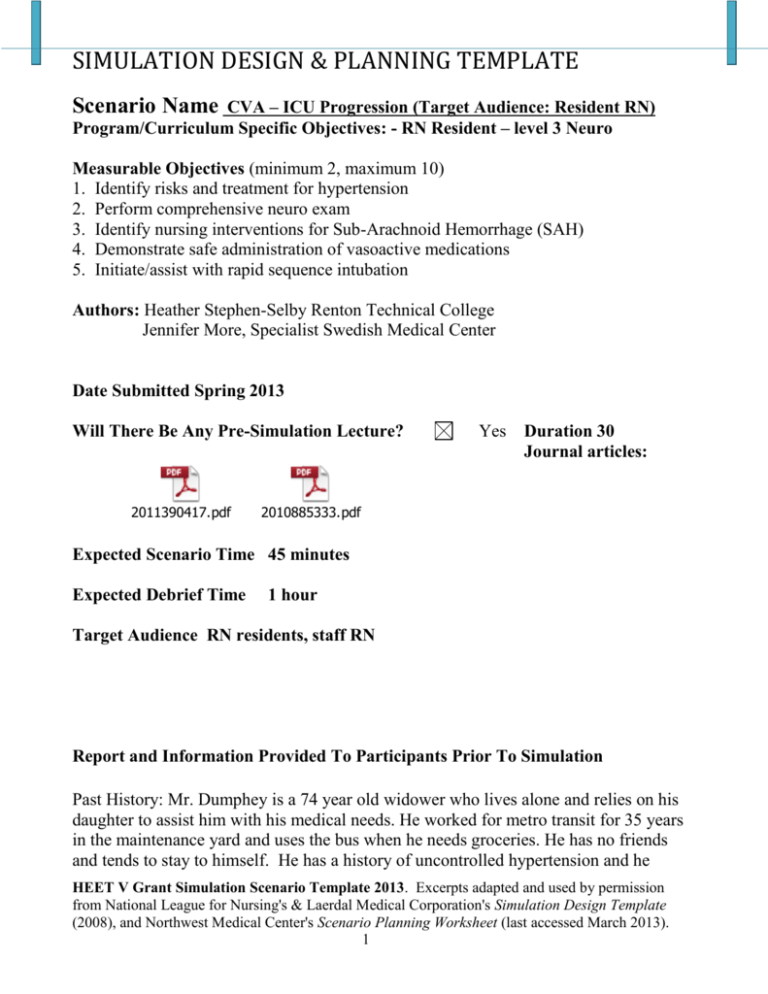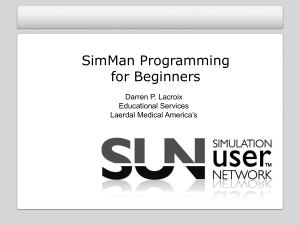Resident Level
advertisement

SIMULATION DESIGN & PLANNING TEMPLATE CVA – ICU Progression (Target Audience: Resident RN) Program/Curriculum Specific Objectives: - RN Resident – level 3 Neuro Scenario Name Measurable Objectives (minimum 2, maximum 10) 1. Identify risks and treatment for hypertension 2. Perform comprehensive neuro exam 3. Identify nursing interventions for Sub-Arachnoid Hemorrhage (SAH) 4. Demonstrate safe administration of vasoactive medications 5. Initiate/assist with rapid sequence intubation Authors: Heather Stephen-Selby Renton Technical College Jennifer More, Specialist Swedish Medical Center Date Submitted Spring 2013 Will There Be Any Pre-Simulation Lecture? 2011390417.pdf Yes Duration 30 Journal articles: 2010885333.pdf Expected Scenario Time 45 minutes Expected Debrief Time 1 hour Target Audience RN residents, staff RN Report and Information Provided To Participants Prior To Simulation Past History: Mr. Dumphey is a 74 year old widower who lives alone and relies on his daughter to assist him with his medical needs. He worked for metro transit for 35 years in the maintenance yard and uses the bus when he needs groceries. He has no friends and tends to stay to himself. He has a history of uncontrolled hypertension and he HEET V Grant Simulation Scenario Template 2013. Excerpts adapted and used by permission from National League for Nursing's & Laerdal Medical Corporation's Simulation Design Template (2008), and Northwest Medical Center's Scenario Planning Worksheet (last accessed March 2013). 1 SIMULATION DESIGN & PLANNING TEMPLATE forgets to take his antihypertensive medications on a regular basis. He was recently diagnosed with atrial fibrillation on his last visit to his doctor 3 months ago. He has started medication. He still smokes 1/2 a pack a day as he has for 50 years even though he has been told to quit by his PCP. His daughter is supportive but exhausted and worried as this is the third time in the past year he has been admitted to the hospital for a fall. Present Illness: Mr. Dumphey is transferring to your ICU for BP management and potential treatment for stroke. On the floor, he developed sudden on-set of word finding difficulty, coughing/distress, and right-sided weakness. He’s been to CT, which shows a sub-arachnoid hemorrhage around, in addition to a left MCA infarct. His daughter is with him. Patient Information Patient Name: Age: 74 Charles Dumphey Birth date: 4/2/1940 Gender: Male Weight: 80 Kg Height: 5’11 ID band MR #00001234 Acct. # 1198765432 Hx. Present Illness: Admitted from the ED with small sub-dural hematoma after falling at home. Getting q4 hour neuro checks. Social History: Widowed. 2 adult children. Smokes ½ pack a day. Does not drive. Religion: Baptist Support System: 2 adult children, daughter involved in care & is local. Allergies: PCN, Shellfish Attending Physician: Past medical history: Immunizations: Flu shot in October Greg Shaw Atrial Fibrillation, Hypertension Physical description of how you want the manikin to present at start of scenario? Moulage: Add picture here: In bed with patient gown, clammy, coughing, anxious HEET V Grant Simulation Scenario Template 2013. Excerpts adapted and used by permission from National League for Nursing's & Laerdal Medical Corporation's Simulation Design Template (2008), and Northwest Medical Center's Scenario Planning Worksheet (last accessed March 2013). 2 SIMULATION DESIGN & PLANNING TEMPLATE Assignment Of Roles (Please indicate below roles to be assigned): Primary Nurse Physician/ Advanced Practice Nurse Secondary Nurse Respiratory Therapy Clinical Instructor Family Member #1 Social Services Unlicensed Assistive Personnel/CNA/MA Code Team List Members: Intensivist arrives to intubate Other: Speech Therapist Important Information Related To Roles: The daughter is in the room. She is concerned about her dad, he seems more uncomfortable and anxious. Questions his BP. SIM Setup Moulage Wounds Bruise L hip Mannequin IV site : Site __Right AC_______ Gauge _18 ___ HEET V Grant Simulation Scenario Template 2013. Excerpts adapted and used by permission from National League for Nursing's & Laerdal Medical Corporation's Simulation Design Template (2008), and Northwest Medical Center's Scenario Planning Worksheet (last accessed March 2013). 3 SIMULATION DESIGN & PLANNING TEMPLATE Fidelity (choose all that apply to this simulation) Setting/Environment Med-Surg ICU Props: Equipment attached to manikin: Primary IV Fluid running at 100 ml/hr in RAC IV IV pump running O2 Monitor attached/ Type ECG leads ID band Equipment available in room: Bedpan/ Urinal Crash cart c airway devices and emergency meds Foley kit Fluids IV tubing IVPB tubing IV pump O2 delivery device & nasal cannula Suction Medications and Fluids: Oral Meds IV Fluids IVPB IV Push Diagnostics Available: Labs Values Other: Head CT Documentation Forms: Physician Orders Flow Sheet MAR Standing (Protocol) Orders: Sepsis Order Set Recommended Mode for Simulation Manual/Programmed Hybrid Significant Lab Values Cr 1.3, Na 135, K 3.4 Physician Orders Bedrest, NPO until swallow screen, Swallow Screen, ASpiration precautions, SAH precautions, Seizure precautions, VS & Neuro Check q1hr, NIHSS on admission then twice daily, DVT Prophylaxis, Pepcid 20mg IV q12hr, Morphine 2mg IV q2h PRN, Keppra 500mg IV Q12h, Nimodipine 60mg PO Q4hr, Nicardipine 5-15mg/hr continuous to keep SBP Less than 160. HEET V Grant Simulation Scenario Template 2013. Excerpts adapted and used by permission from National League for Nursing's & Laerdal Medical Corporation's Simulation Design Template (2008), and Northwest Medical Center's Scenario Planning Worksheet (last accessed March 2013). 4 SIMULATION DESIGN & PLANNING TEMPLATE Scenario Progression Outline State 1 Initial Amount Time in Initial Stage- 5 mins Baseline Vital Signs T 37.4, 115, 26 BP 172/94 SPO2 92% RA Cardiac Rhythm ST Breath Sounds Coarse Crackles Heart Sounds WNL Abdominal Sounds WNL Other Symptoms: Anxious, coughing, Verbalization (Pt/Manikin Cues) “My head hurts.” (slurred) Slow to respond to RN, restless Expected Interventions Alternate or Incorrect Treatment Choice That Will Affect Outcome Respiratory decompensation if no O2 applied. Identify self Reassure pt Assess pt, note neuro exam Next BP – 200/90 variations Assess VS Note low SpO2 & elevated BP Call MD on phone, using SBAR Confederate Actions/Additional Role Player Cues “I’ve never seen his BP THAT high!” “What are you going to give him for pain?” “What did the results of the scan show?” VORB Color Key: Patient speaking Daughter speaking Correct Treatment Choice State 2 Timing Sequence Expected interventions Receives orders from Start drip and MD on phone to start titrate for BP in Nicardipine drip and goal. keep SBP less than 150; oxygen by nasal cannula Complete to keep FiO2 > 95%; swallow screen, acetaminophen 650mg chart & stop w/ po now and q 6 hours. facial droopremains NPO. Call Speech therapy. Correct Treatment choice State 3 Timing Sequence Expected 2 hours later Interventions Baseline Vital Signs Call rapid response T 38.6 team P 110 Anticipate R 22 intubation BP 200/98 SPO2 89% on 2 L/NP Cardiac Rhythm ST Breath Sounds unchanged Heart Sounds WNL Abdominal Sounds WNL Other Symptoms: Unresponsive, L pupil larger than R. HEET V Grant Simulation Scenario Template 2013. Excerpts adapted and used by permission from National League for Nursing's & Laerdal Medical Corporation's Simulation Design Template (2008), and Northwest Medical Center's Scenario Planning Worksheet (last accessed March 2013). 5 SIMULATION DESIGN & PLANNING TEMPLATE Correct Treatment ChoiceState 4 Timing Sequence Expected 2 hours later Interventions Baseline Vital Signs Assist with T 38.2 intubation. P 120 Give medications R 28 as ordered. BP 150/80 Communicate w/ SPO2 91% on 4 L/NP RT & team. Cardiac Rhythm ST Breath Sounds labored Heart Sounds WNL Abdominal Sounds WNL Other Symptoms: HEET V Grant Simulation Scenario Template 2013. Excerpts adapted and used by permission from National League for Nursing's & Laerdal Medical Corporation's Simulation Design Template (2008), and Northwest Medical Center's Scenario Planning Worksheet (last accessed March 2013). 6 SIMULATION DESIGN & PLANNING TEMPLATE Instructor Check List (return to CHESC assistant at the end of class) Pre-Scenario Check List 1. 2. 3. 4. 5. 6. 7. 8. Equipment is staged as requested. The learner has been oriented to the simulator. The learner understands the guidelines/expectations for the scenario. Participants understand their assigned roles. The time frame Expectations for simulation met: Yes No. The time frame Expectations for debrief met: Yes No. Audio/Visual Consent signed and turned into CHESC sheet. Attendance sheet completed and given to CHESC staff. Post Scenario If you could change anything next time, what would it be? Comments: ________________________________________________________ ________________________________________________________ ________________________________________________________ CHESC Assistant Name: Did the person provide excellent support for the scenario? Yes No Comment Instructor signature ________________________________ Date ________________________ HEET V Grant Simulation Scenario Template 2013. Excerpts adapted and used by permission from National League for Nursing's & Laerdal Medical Corporation's Simulation Design Template (2008), and Northwest Medical Center's Scenario Planning Worksheet (last accessed March 2013). 7 SIMULATION DESIGN & PLANNING TEMPLATE Participant Check List (return to Instructor at the end of class) Pre-Scenario Check List 1. 2. 3. 4. 5. I have been oriented to the simulator. I understand the guidelines/expectations for the scenario. I understand the assigned role. My questions about the simulation have been answered. I have all necessary equipment for the simulation. Post Scenario If you could change anything next time, what would it be? Comments: ________________________________________________________ ________________________________________________________ ________________________________________________________ ________________________________________________________ Participant Signature ____________________________________ Date ________________________ HEET V Grant Simulation Scenario Template 2013. Excerpts adapted and used by permission from National League for Nursing's & Laerdal Medical Corporation's Simulation Design Template (2008), and Northwest Medical Center's Scenario Planning Worksheet (last accessed March 2013). 8 SIMULATION DESIGN & PLANNING TEMPLATE Simulation Post-Assessment Methods Checklist Tests Evaluations Turning Point Jeopardy Other Optional Literature References American Association of Neuroscience Nurses (AANN) (2009) Care of the Patient with Aneurysmal Subarachnoid Hemorrhage. Practice Guideline Series. Debriefing Guidelines (Remember to identify important concepts or curricular threads that are specific to your program) 1. Leave the simulation room and go to a conference room, if possible. It allows for deescalation of emotions. 2. Solicit and validate emotions briefly. Validate simisms (the simulation isn’t 100% accurate due to different equipment, personnel etc) 3. What went WELL in this simulation? 4. What DID NOT go well in this simulation? 5. If you could do it again, what would you do differently? 6. Summarize: “What I hear you saying is . . .” HEET V Grant Simulation Scenario Template 2013. Excerpts adapted and used by permission from National League for Nursing's & Laerdal Medical Corporation's Simulation Design Template (2008), and Northwest Medical Center's Scenario Planning Worksheet (last accessed March 2013). 9 SIMULATION DESIGN & PLANNING TEMPLATE HEET V Grant Simulation Scenario Template 2013. Excerpts adapted and used by permission from National League for Nursing's & Laerdal Medical Corporation's Simulation Design Template (2008), and Northwest Medical Center's Scenario Planning Worksheet (last accessed March 2013). 10







